At the base of Pavagadh Hill is the village of Champaner – a living village with a lot of heritage monuments of medieval architecture scattered across the village. It is a part of the Champaner Pavagadh world heritage site. We had first visited the Pavagadh hill or rather almost climbed it.

Champaner, Gujarat
We were totally exhausted by the time we reached the village and the sun did not help either. Nonetheless, the fort walls that kind of define the boundaries of the heritage place were inviting. We started our exploration of medieval architecture here – the capital city of Mahmud Begada. Curiously the name Begada comes from the fact that he had two forts – Be+Gada – Be in Gujarati means two and Gadh means fort.

We were told that in its hay days, the place had beautiful pleasure gardens and pavilions called Baradari. A feature that you see in all Mughal monuments too. Either to replicate the designs of their homeland or to create heaven as described in their holy book. As you walk through the village, you can see the ruins. Lots of open pavilions and corridors made of stone. Most of which are still being used by the villagers as public spaces.
Sahar Ki Masjid at Champaner

The Sahar ki Masjid was the first imposing architectural piece that we admired. Long mosque with five big but low domes. And many small domes are arranged symmetrically on top of the roof. The two tall Minar with their heavily carved base look straight out of a Jain temple and stand on both sides of the central arch. Inside too, the carvings on the five mihrabs resemble the temple altars. Probably the artisans who built this were used to building temples. And the stylistic identities were not yet so well established.
Pillars arranged in a circle beneath the domes created an interesting geometry for the eye. What I remember the most inside this mosque is the cool comfort it provided in the afternoon heat.
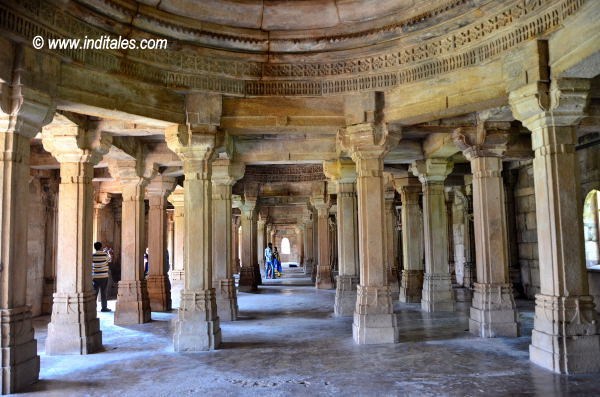

Mandvi or Customs House
Not too far from Sahar ki Masjid is a square structure called Mandvi or Customs House. It has served as a place for security guards and a custom collection point at different points in time. Essentially Mandvi separates the royal area from the public area. The pillared arches of Mandvi create an interesting play for the camera. As you keep looking for the perfect place to capture them all in their entirety. But then medieval architecture was hardly meant to be camera friendly.

Jami Masjid at Champaner
A little distance away near a water body stands another beautiful mosque with some of the best latticework you can see in the history of architecture. It actually lies outside the royal quarters. I assume because it is supposed to be a congregational mosque. The beauty of the mosque, though, conveys that public mosques were as beautiful as the private royal mosques if not better. You enter this mosque through an open enclosure that has some lovely carvings on its walls and arches.
I wonder what the purpose of this open pavilion would be, maybe it was covered with a cloth when in use. This mosque too had five arches and the central one has tall pillars that look like Minar’s. These pillars are heavily carved at the base.
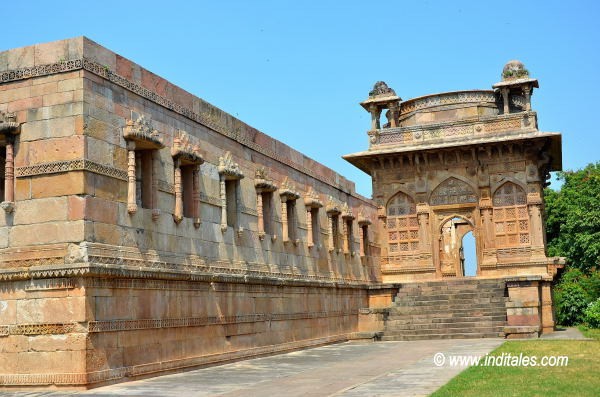
Jami Masjid has a perforated wall inside its Northside separating the area for the women. It at least told me that women were allowed inside the mosque even if they were restricted to the area marked for them.
Noteworthy features of both mosques are the carvings on the ceilings or the base of the domes.

I could not visit the Nagina Mosque. And some other mosques as the car could not go there. The walk through the fields for a few km did not seem feasible in the sun. However, I wandered around and saw a pavilion at the edge of a lake called Vada Talao that looked just perfect for the hot weather of the region. I later learned that this pavilion is called Kabutar Khana for the number of pigeon holes in its walls. The view of Pavagadh Hill from here is panoramic.

Helical Step Well
On our way back to Ahmedabad, we stopped at a helically shaped waterbody – which the students of architecture tell me is quite unique for its shape. Built sometime in 16th CE, this step well uses brick and stone and its steps are similar to any other step well. I could not figure out the reason behind this curious shape. Various lakes and stepwells must have been built to harvest the scanty rainfall that this region gets. And the need to preserve that. Even on top of Pavagadh Hill, you see small lakes.
Preservation
The heritage place here can do with some more preservation. Some signage definitely would help travelers to see all the places. We had to constantly ask and look for places throughout the place except for the two famous mosques. Thankfully I carried my ASI guide that I always recommend for visiting any UNESCO world heritage site in India.
Recommend you to read the following travel blog on Places to visit in Gujarat.
The Legacy of a Queen – Rani Ki Vav


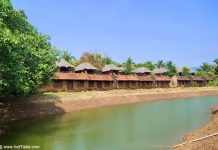

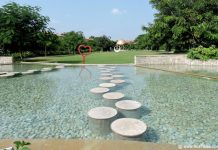

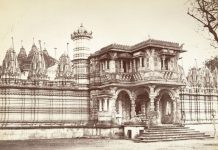







Beautiful, would really love to visit this place someday. Thanks for the share!
Happy that you liked it Velysia.
Thanks for all the information! Lovely photos. How does one get there ?
Kalpana, It is a good day trip from either Vadodara or Ahmedabad. I would suggest take a taxi and go but I am sure there is enough public transport available too.
Such a lovely description of the World heritage site. After reading your blog post, I would certainly like to visit it sometime in near future.
Thanks Thirtha. So share your views after you have been there. And do check out other world heritage sites covered on the blog.
Nice to know more about Champaner and its architecture. They look gorgeous!
Thanks Niranjan.
I would love to have you cover the Yogini Temples and your views on the same.
Suneel, I also want to see Yogini temples around the Indian subcontinent – hope that the universe is listening.
Indus Valley Civilisation, also known as ‘Harappan Civilisation’, was discovered as a consequence of the excavations conducted in 1920. The culture of Indus Valley Civilization manifested the growth of an ancient society that evolved and thrived during the Bronze Age in the North-West region of India and its subcontinent.